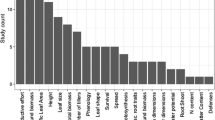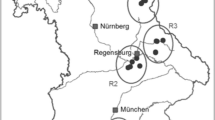Abstract
Current land use and climate change are prompting questions about the ability of plants to adapt to such environmental change. Therefore, we experimentally addressed plant performance and quantitative-genetic diversity of the common Alpine Meadow Grass Poa alpina. We asked how land use and altitude affect the occurrence of P. alpina in the field and whether its common-garden performance suggests adaptation to conditions at plant origin and differences in quantitative genetic diversity among plant origins. Among 216 candidate grassland sites of different land use and altitude from 12 villages in the Swiss Alps, P. alpina occurred preferentially in fertilized and grazed sites and at higher elevations. In a common garden at 1,500 m asl, we grew two plants of >600 genotypes representing 78 grassland sites. After 2 years, nearly 90% of all plants had reproduced. In agreement with adaptive advantages of vegetative reproduction at higher altitudes, only 23% of reproductive plants from lower altitudes reproduced via vegetative bulbils, but 55% of plants from higher altitudes. In agreement with adaptive advantages of reproduction in grazed sites, allocation to reproductive biomass was higher in plants from grazed grasslands than from mown ones. For 53 grasslands, we also investigated broad-sense heritability H2, which was significant for all studied traits and twice as high for grazed as for mown grasslands. Moreover, possibly associated with their higher landscape diversity, H2 was higher for sites of villages of Romanic cultural tradition than for those of Germanic and Walser traditions. We suggest promoting diverse land use regimes to conserve not only landscape and plant species diversity, but also adaptive genetic differentiation and heritable genetic variation.






Similar content being viewed by others
References
Abrahamson WG (1980) Demography and vegetative reproduction. In: Solbrig OT (ed) Demography and evolution in plant populations. Blackwell, NJ, pp 89–106
Assefa K, Tefera H, Merker A, Kefyalew T, Hundera F (2001) Variability, heritability and genetic advance in phenomorphic and agronomic traits of tef (Eragrostis tef (Zucc.) Trotter) germplasm from eight regions of Ethiopia. Hereditas 134:103–113
Bachmann MA (1980) Ökologie und Breeding System bei Poa alpina L. PhD Thesis. Univerität Zürich, Zürich, Switzerland
Bätzing W (1991) Romanische und germanische Berglandwirtschaft. In: Die Alpen—Entstehung und Gefährdung einer europäischen Kulturlandschaft. C.H. Beck, München, pp 33–44
Bätzing W (1993) Der sozio-ökonomische Strukturwandel des Alpenraumes im 20. Jahrhundert. Geographisches Institut der Universität Bern, Bern
Bätzing W (2003) Die Alpen—Geschichte und Zukunft einer europäischen Kulturlandschaft. C.H. Beck, München
Billings W (1974) Arctic and alpine vegetation: plant adaptations to cold summer climates. In: Ives J, Barry R (eds) Arctic and alpine environments. Methuen, London, pp 403–443
Bliss L (1972) Arctic and alpine plant life cycles. Annu Rev Ecol System 2:405–438
Burnham KP, Anderson DR (2002) Model selection and multimodel inference: a practical information-theoretic approach, 2nd edn. Springer, New York
Byars SG, Hoffmann AA (2009) Lack of strong local adaptation in the alpine forb Craspedia lamicola in southeastern Australia. Int J Plant Sci 170:906–917
Byars SG, Papst W, Hoffmann AA (2007) Local adaptation and cogradient selection in the alpine plant, Poa hiemata, along a narrow altitudinal gradient. Evolution 61:2925–2941
Byars SG, Parsons Y, Hoffmann AA (2009) Effect of altitude on the genetic structure of an Alpine grass, Poa hiemata. Ann Bot 103:885–899
Conert HJ (1998) Poa alpina. In: Gustav Hegi Illustrierte Flora von Mitteleuropa. Parey Buchverlag, Berlin, pp 690–693
Duckert-Henriod MM, Favarger C (1987) Contribution à la cytotaxonomie et à la cytogéographie des Poa (Poaceae = Gramineae) de la Suisse. Birkhäuser, Basel
Ellenberg H, Weber HE, Düll R, Wirth V, Werner W, Paulssen D (1992) Zeigerwerte von Pflanzen in Mitteleuropa. Scripta Geobotanica 18
Ellenberg H (1996) Vegetation Mitteleuropas mit den Alpen, 5th edn. Ulmer, Stuttgart
Ellmer M, Prentice HC, Andersson S (2011) The structuring of quantitative genetic variation in a fragmented population of Briza media (Poaceae). Evol Ecol 25:509–523
Falconer DS, MacKay TFC (1996) Introduction to quantitative genetics. Pearson Longman, London
Fischer M, Rudmann-Maurer K, Weyand A, Stöcklin J (2008) Agricultural land use and biodiversity in the Alps—how cultural tradition and socioeconomically motivated changes are shaping grassland biodiversity in the Swiss Alps. Mt Res Dev 28:148–155
Fischer M, van Kleunen M (2001) On the evolution of clonal plant life histories. Evol Ecol 15:565–582
Fischer M, van Kleunen M, Schmid B (2004) Experimental life-history evolution: selection on growth form and its plasticity in a clonal plant. J Evol Biol 17:331–341
Fischer M, Wipf S (2002) Effect of low-intensity grazing on the species-rich vegetation of traditionally mown subalpine meadows. Biol Conserv 104:1–11
Gedge KE, Maun MA (1994) Compensatory response of two dune annuals to simulated browsing and fruit predation. J Veg Sci 5:99–108
Gimenez-Benavides L, Escudero A, Iriondo JM (2007) Local adaptation enhances seedling recruitment along an altitudinal gradient in a high mountain Mediterranean plant. Ann Bot 99:723–734
Gomez JM, Fuentes M (2001) Compensatory responses of an arid land crucifer, Chorispora tenella (Brassicaceae), to experimental flower removal. J Arid Environ 49:855–863
Gonzalo-Turpin H, Hazard L (2009) Local adaptation occurs along altitudinal gradient despite the existence of gene flow in the alpine plant species Festuca eskia. J Ecol 97:742–751
Grubb PJ (1977) Maintenance of species-richness in plant communities—importance of regeneration niche. Biol Rev Cambridge Philos Soc 52:107–145
Harmer R, Lee JA (1978) Germination and viability of Festuca vivipara (L.) Sm. plantlets. New Phytol 81:745–751
Hautier Y, Randin CF, Stöcklin J, Guisan A (2009) Changes in reproductive investment with altitude in an alpine plant. J Plant Ecol 2:125–134
Heide OM (1989) Environmental control of flowering and viviparous proliferation in seminiferous and viviparous arctic populations of two Poa species. Arctic Alpine Res 21:305–315
Kikvidze Z, Michalet R, Brooker RW, Cavieres LA, Lortie CJ, Pugnaire FI, Callaway RM (2011) Climatic drivers of plant-plant interactions and diversity in alpine communities. Alpine Bot 121:63–70
Kölliker R, Stadelmann FJ, Reidy B, Nösberger J (1998) Fertilization and defoliation frequency affect genetic diversity of Festuca pratensis Huds. in permanent grasslands. Mol Ecol 7:1557–1567
Körner C (2003) Alpine plant life—functional plant ecology of high mountain ecosystems, 2nd edn. Springer, Berlin
Landolt E (1977) Ökologische Zeigerwerte zur Schweizer Flora. Geobotanisches Institut der ETH, Zürich
Leimu R, Fischer M (2008) A meta-analysis of local adaptation in plants. PLoS One 3:e4010
Lennartsson T, Nilsson P, Tuomi J (1998) Induction of overcompensation in the field gentian, Gentianella campestris. Ecology 79:1061–1072
Machon N, Guillon JM, Dobigny G, Le Cadre S, Moret J (2001) Genetic variation in the horsetail Equisetum variegatum Schleich., an endangered species in the Parisian region. Biodiv Conserv 10:1543–1554
Marcante S, Winkler E, Erschbamer B (2009) Population dynamics along a primary succession gradient: do alpine species fit into demographic succession theory? Ann Bot 103:1129–1143
Maurer K, Gautschi B, Weyand A, Stöcklin J, Fischer M (2005) Isolation and characterization of microsatellite DNA markers in the grass Poa alpina L. Mol Ecol Notes 5:719–720
Maurer K, Weyand A, Fischer M, Stöcklin J (2006) Old cultural traditions, in addition to land use and topography, are shaping plant diversity of grasslands in the Alps. Biol Conserv 130:438–446
Meirmans PG, Vlot EC, Den Nijs JCM, Menken SBJ (2003) Spatial ecological and genetic structure of a mixed population of sexual diploid and apomictic triploid dandelions. J Evol Biol 16:343–352
Müntzing A (1933) Apomicitc and sexual seed formation in Poa. Hereditas 17:131–154
Müntzing A (1980) Mode of propagation and chromosomal peculiarities in Scotch material of Poa alpina. Hereditas 92:291–296
Odat N, Hellwig FH, Jetschke G, Fischer M (2010) On the relationship between plant species diversity and genetic diversity of Plantago lanceolata (Plantaginaceae) within and between grassland communities. J Plant Ecol 3:41–48
Odat N, Jetschke G, Hellwig FH (2004) Genetic diversity of Ranunculus acris L. (Ranunculaceae) populations in relation to species diversity and habitat type in grassland communities. Mol Ecol 13:1251–1257
Olsson EGA, Austrheim G, Grenne SN (2000) Landscape change patterns in mountains, land use and environmental diversity, Mid-Norway (1960–1993. Landsc Ecol 15:155–170
Pierce S, Stirling CM, Baxter R (2000) Architectural and physiological heterogeneity within the synflorescence of the pseudoviviparous grass Poa alpina var. vivipara L. J Exp Bot 51:1705–1712
Reisch C, Anke A, Röhl M (2005) Molecular variation within and between ten populations of Primula farinosa (Primulaceae) along an altitudinal gradient in the northern Alps. Basic Appl Ecol 6:35–45
Reisch C, Poschlod P (2003) Intraspecific variation, land use and habitat quality—a phenologic and morphometric analysis of Sesleria albicans (Poaceae). Flora 198:321–328
Reisch C, Poschlod P (2009) Land use affects flowering time: seasonal and genetic differentiation in the grassland plant Scabiosa columbaria. Evol Ecol 23:753–764
Rudmann-Maurer K, Weyand A, Fischer M, Stöcklin J (2007) Microsatellite diversity of the agriculturally important alpine grass Poa alpina in relation to land use and natural environment. Ann Bot 100:1249–1258
Rudmann-Maurer K, Weyand A, Fischer M, Stöcklin J (2008) The role of landuse and natural determinants for grassland vegetation composition in the Swiss Alps. Basic Appl Ecol 9:494–503
Scheepens JF, Frei ES, Stöcklin J (2010) Genotypic and environmental variation in specific leaf area in a widespread Alpine plant after transplantation to different altitudes. Oecologia 164:141–150
Schwarzenbach FH (1953) Die Abhängigkeit der Bulbillenbildung bei Poa alpina vivipara von Photoperiodismus und Frost. Experientia 9:96–96
Silvertown JW, Charlesworth D (2001) Introduction to plant population biology, 4th edn. Blackwell, NJ
Stearns SC (1980) A new view of life-history evolution. Oikos 35:266–281
Stearns SC (1992) The evolution of life histories. Oxford University Press, Oxford
Steiner AM, Heidenreich SC, Schwarz P (1997) Verification of varieties of alpine meadow-grass (Poa alpina L.) floret morphology, chromosome number and single seed storage protein electrophoresis. Plant Var Seeds 10:129–134
Stöcklin J, Kuss P, Pluess AR (2009) Genetic diversity, phenotypic variation and local adaptation in the alpine landscape: case studies with alpine plant species. Bot Helv 119:125–133
Theurillat J-P, Schlüssel A, Geissler P, Guisan A, Velluti C, Wiget L (2003) Vascular plant and bryophyte diversity along elevational gradients in the Alps. In: Nagy L, Grabherr G, Körner C, Thompson DBA (eds) Alpine biodiversity in Europe. Springer, Berlin, pp 185–193
Trtikova M, Edwards PJ, Güsewell S (2010) No adaptation to altitude in the invasive plant Erigeron annuus in the Swiss Alps. Ecography 33:556–564
van Kleunen M, Fischer M, Schmid B (2001) Effects of intraspecific competition on size variation and reproductive allocation in a clonal plant. Oikos 94:515–524
van Kleunen M, Ramponi G, Schmid B (2004) Effects of herbivory simulated by clipping and jasmonic acid on Solidago canadensis. Basic Appl Ecol 5:173–181
Vellend M, Geber MA (2005) Connections between species diversity and genetic diversity. Ecol Lett 8:767–781
Vellend M (2004) Parallel effects of land-use history on species diversity and genetic diversity of forest herbs. Ecology 85:3043–3055
Winkler E, Marcante S, Erschbamer B (2010) Demographic consequences of the two reproductive modes in Poa alpina L. along a primary succession gradient in the Central Alps. Arctic Antarctic Alpine Res 42:227–235
Acknowledgments
We are grateful to Christine and Kai Huovinen-Hufschmid for providing land and care for our plants. We also thank numerous student workers for their great help in the field and lab, all municipalities and farmers for the permission to work on their land, and Mark van Kleunen, Oliver Bossdorf and two anonymous reviewers for helpful comments on previous drafts of the manuscript. This study was financed by the Swiss National Science Foundation SNF (grant 4048-064494/1 within the National Research Program 48 “Landscapes and Habitats of the Alps”).
Author information
Authors and Affiliations
Corresponding author
Rights and permissions
About this article
Cite this article
Fischer, M., Weyand, A., Rudmann-Maurer, K. et al. Adaptation of Poa alpina to altitude and land use in the Swiss Alps. Alp Botany 121, 91–105 (2011). https://doi.org/10.1007/s00035-011-0096-2
Received:
Accepted:
Published:
Issue Date:
DOI: https://doi.org/10.1007/s00035-011-0096-2




